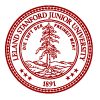Colloquium: Romain Michon and Nick Gang, Christoph Hohnerlein, and Maximilian Rest
Please join us for talks from Romain Michon and Nick Gang, Christoph Hohnerlein, and Maximilian Rest.
-
Romain Michon and Nick Gang
A Faust Based Audio Engine for the Stanford Driving Simulator
Since the beginning of this summer, CCRMA, CDR (Center for Design Research), University of Michigan and Renault Innovation Silicon Valley unified forces to work on a project at VAIL (Volkswagen Automotive Innovation Lab) on “Investigating the influence of audible cues on Driver Situational Awareness - A simulator study comparing driver awareness of audible and visible events in an autonomous vehicles”. As part of this project, a 3d sound system was installed in the simulator and a custom audio engine using Faust was built from scratch and interfaced with the simulator software. After describing the overall implementation of the new sound system and audio engine of the Stanford driving simulator, we’ll provide a series of performance measurements as well as updates on the current state of the project.
-
Christoph Hohnerlein
Beamforming for crosstalk cancellation
Crosstalk is the (generally) unwanted leakage of information between parallel transmission channels. In the audio domain, the most common form appears in speaker-based reproduction setups, when for example sound of the left channel reaches the right ear and vice versa. During his stay at CCRMA, Chris worked on optimizing the radiation patterns of linear speaker arrays in order to suppress the crosstalk between the ears of a listener. Convex optimization in the time domain was used to enforce low frequency distortion or low amplitude at certain angles. The resulting system allows for independent control of the signals emerging at the listener’s ears so that, for example, HRTF-based 3D audio reproduction can be performed. Simulations suggest that suppression of up to 50 dB may be achieved for a frequency range spanning several octaves. He also helped build several arduino-based head trackers, wrote a max4live plugin to remote control the SSR renderer and explored a new sound synthesis method.
-
Maximilian Rest
Towards a universal real-time wave digital filter framework
Wave Digital Filters (WDF) have been used since many years for physical- and virtual-analog modeling of acoustic systems but were very limited in their topologies and the flexibility with non-linear elements in the past. Over the last one and a half years, researchers at CCRMA have contributed great advances in this field and recently presented solutions to accomplish arbitrary circuit structures and multiple nonlinearities to the community. During his three month stay at CCRMA, Maximilian Rest initiated the development of a universal real-time wave digital filter framework in C++ that implements these recent results and makes them easily accessible. His talk will give an introduction to the framework's structure, show some examples how to use it and concludes with real-time live demonstrations.

